1. Introduction: What is a fossil?
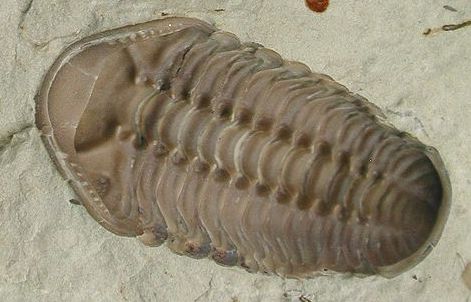
The image on the right is a fossil of an extinct animal called a trilobite. Trilobites are evolutionary relatives of crabs and insects. They lived in Earth’s ancient oceans from 521 to 252 million years ago.
Fossils are the petrified remains of any once-living thing from the past. Petrified means turned into stone. As we’ll see below, fossils are another piece of evidence for evolution.
2. How do Fossils Form?
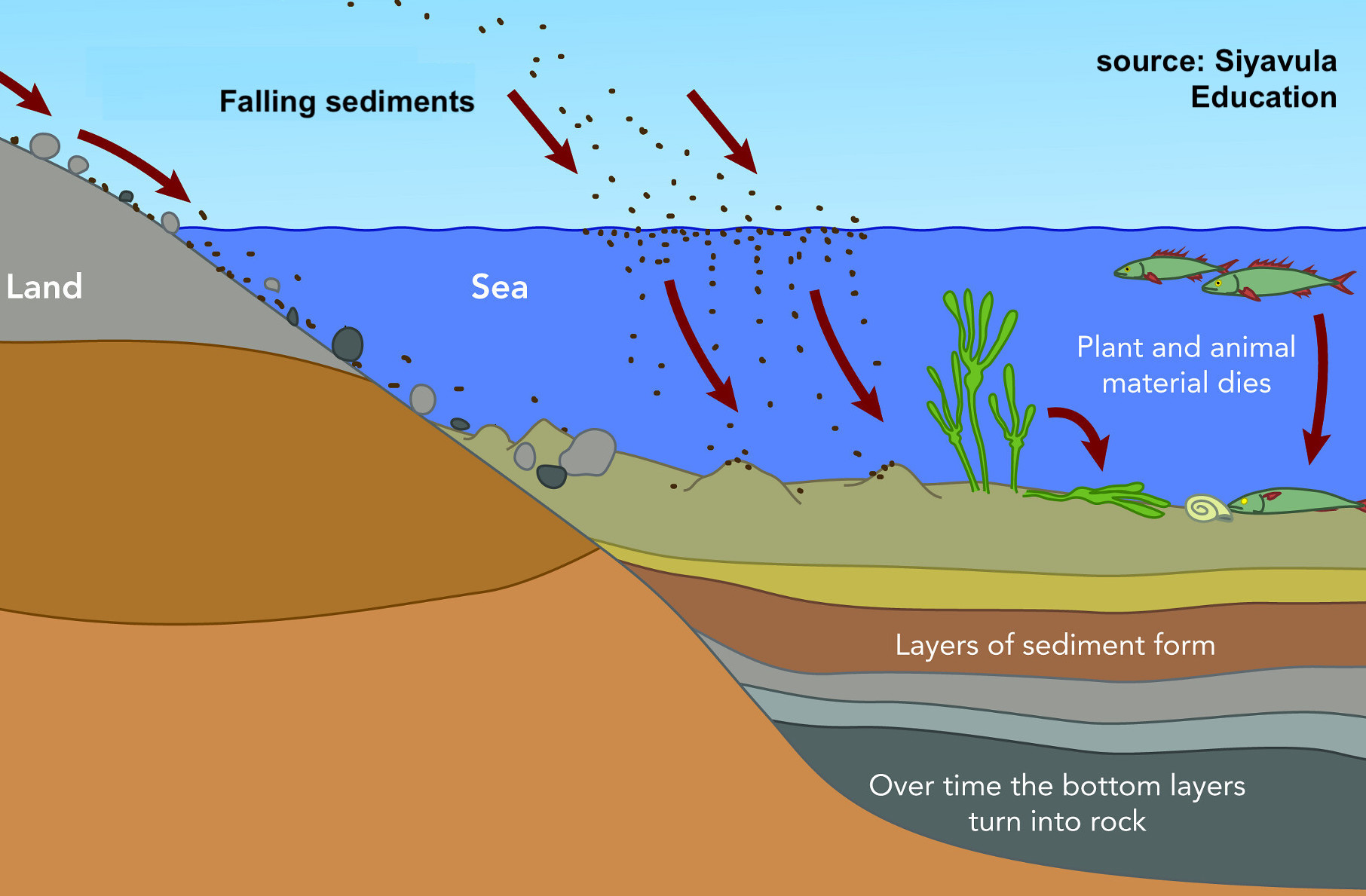
When an organism dies, most or all of its body gets broken down, leaving no trace. However, if the organism dies in an area where sedimentary rocks are forming, some or all of its body can become fossilized (preserved as a fossil).
Sedimentary rocks form as deposited material (sediment) brought by gravity, wind, rivers, or ocean currents builds up in layers, usually in a body of water, as shown at left.
 The diagram at right shows fossil formation at work. Death (1) is followed by burial in sediments (2). Burial keeps the skeleton from being torn apart by animals or broken apart by currents of water. Over time, minerals in the water replace the organic material in the organism’s bones (3), creating a fossil.
The diagram at right shows fossil formation at work. Death (1) is followed by burial in sediments (2). Burial keeps the skeleton from being torn apart by animals or broken apart by currents of water. Over time, minerals in the water replace the organic material in the organism’s bones (3), creating a fossil.
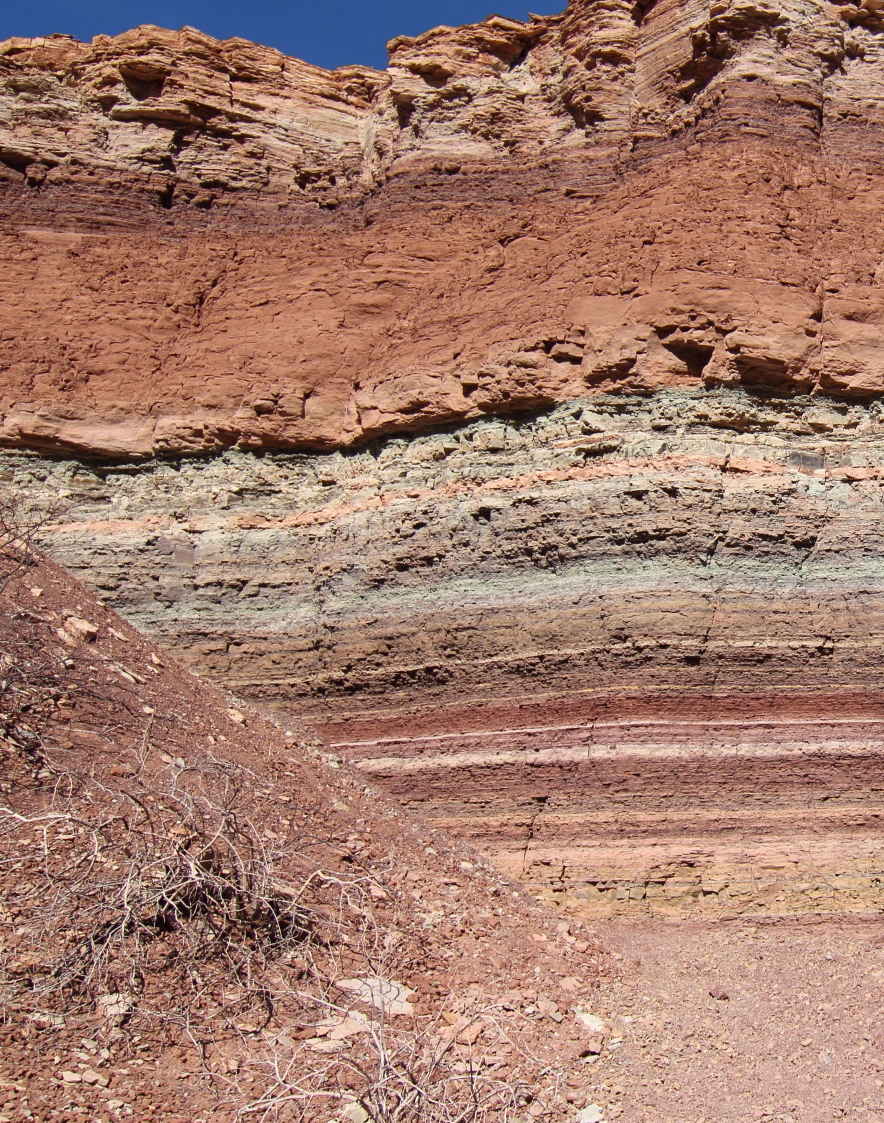
Layers of sedimentary rock are called strata. In the field, sedimentary strata (when exposed on land), look like what’s shown on the left. Because these are sedimentary strata, it’s possible that fossils might be embedded within them.
If you were to find a fossilized fish within these strata, it might look like this:
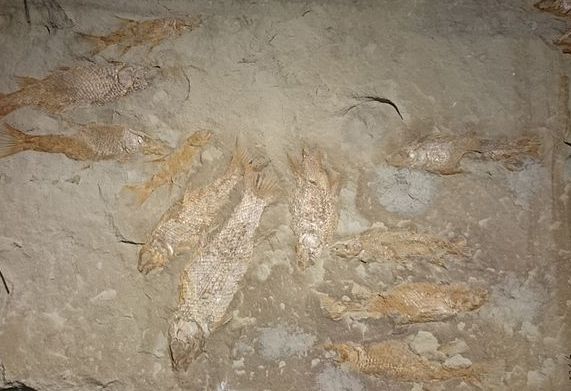
Fossils can also be formed as molds or casts of an organism’s body. This can happen as a shell, bone, or another hard part of the organism presses into soft sediments, which then solidify, creating an impression.
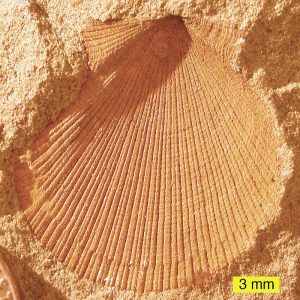
Sometimes, molds or casts of soft body parts can occur. But in general, hard body parts are fossilized much more easily than soft body parts.
The fossil record is the history of life as documented by fossils. Because of the way fossils form, the fossil record is much more complete for organisms with shells, skeletons, exoskeletons, or other hard, parts than it is for soft-bodied organisms.
The fossil record is vast, but it’s also incomplete. According to an article in the Proceedings of the National Academy of Sciences, “About 192,000 invertebrate fossil species were known in 1970, and at least 3,000 more are named every year.” Based on this, the number of known fossil species in 2020 would be over 300,000. That’s a lot of fossils. But since the number of species that have ever lived might be as high as 5 billion, the fossil record represents much less than 1/10,000 of one percent of all life.
3. Fossils and the Fossil Record: Flashcards
[qdeck qrecord_id=”sciencemusicvideosMeister1961-Fossils and the Fossil Record (HS)”]
[h]Fossils and the Fossil Record
[i]Archaepteryx, a fossilized bird-like dinosaur, possibly an ancestor of today’s birds
[q]Define the word “fossil.”
[a]Fossil: the petrified remains of any once-living thing from the past.
[q]Petrified means …
[a]Petrified means turned to stone.
[q]How do fossils form? You can base your explanation on the diagram below:
[a]Fossils form when a dead animal (at 1) gets buried in sediments (2). Over time, minerals in the water replace the material in the bones, creating a fossil (3).
[q]Fossils only form in _________________ rock.
[a]Fossils only form in sedimentary rock.
[q]What is the fossil record?
[a]The fossil record is the history of life as documented by fossils.
[q]The fossil record is less complete for _________________, and much more complete for ____________.
[a]The fossil record is less complete for organisms with soft bodies, or the soft body parts of any organism. The fossil record and much more complete for organisms with shells, skeletons, exoskeletons, or any other hard parts.
[q]It’s said that “the fossil record is vast but incomplete.” Explain.
[a]The fossil record is vast because hundreds of thousands of fossils have been found. It’s incomplete because that represents only a tiny fraction of all of the organisms that have ever lived.
[/qdeck]
4. Knowing the Age of a Fossil
There are two methods that are used to determine the age of a fossil.
4a. Relative Dating
Relative dating tells you how old a fossil is compared to other fossils.
 Because of the way sediments are laid down, sedimentary rock layers that are closer to the surface are assumed to be younger, while those lower down are assumed to be older. Note that this isn’t always true: sometimes rock layers can be pushed onto their sides, or even flipped over. But aside from that, if you were digging through sedimentary layers and found a sequence of fossils like the one shown on the left, you could assume that the deeper you dig, the older the layers would be. You wouldn’t know the exact age of the fossil, but you would know how old they are relative to one another. That’s why it’s called relative dating.
Because of the way sediments are laid down, sedimentary rock layers that are closer to the surface are assumed to be younger, while those lower down are assumed to be older. Note that this isn’t always true: sometimes rock layers can be pushed onto their sides, or even flipped over. But aside from that, if you were digging through sedimentary layers and found a sequence of fossils like the one shown on the left, you could assume that the deeper you dig, the older the layers would be. You wouldn’t know the exact age of the fossil, but you would know how old they are relative to one another. That’s why it’s called relative dating.
 Index fossils are abundant and easily recognized fossils that are used to define a particular span of geological time. For example, if you know that the fossils in strata # 7 in Montana are about 100 million years old, then the presence of these same fossils in strata # 5 in Texas indicates that this stratum is from the same time period.
Index fossils are abundant and easily recognized fossils that are used to define a particular span of geological time. For example, if you know that the fossils in strata # 7 in Montana are about 100 million years old, then the presence of these same fossils in strata # 5 in Texas indicates that this stratum is from the same time period.
4b. Radiometric or Absolute Dating
With radiometric or absolute dating, you can determine how long ago a fossil formed.
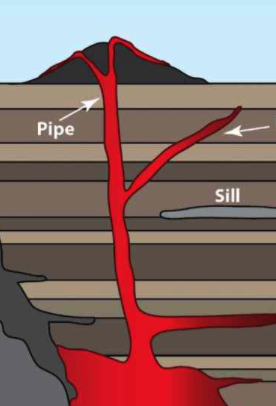
The term “radiometric” combines the words “radiation” and “measurement.” Radiometric dating can only be done with igneous rock. Igneous means that the rocks were once melted magma or lava, which then cooled.
Since fossils always form in sedimentary rock, scientists date fossils by finding volcanic rocks in nearby strata. For example, in the image to the left, volcanic rock (labeled as “pipe” or “sill”) has intruded into sedimentary strata.
Volcanic rock contains radioactive isotopes. These are atoms of elements that emit particles and energy. When radioactive isotopes lose certain particles, they can change into isotopes of other elements For example, the element Uranium has a radioactive isotope that’s called Uranium 238 (U238). Over time, U238 changes into lead 206 (Pb206).
The loss of particles from radioactivity is called radioactive decay, and it occurs at a predictable rate. That rate is known as the half-life, and it’s the time it takes for half of a sample of a radioactive element to transform itself into another element. For example, it takes uranium 238 (238U) 4.5 billion years to decay into lead 206 (206Pb).
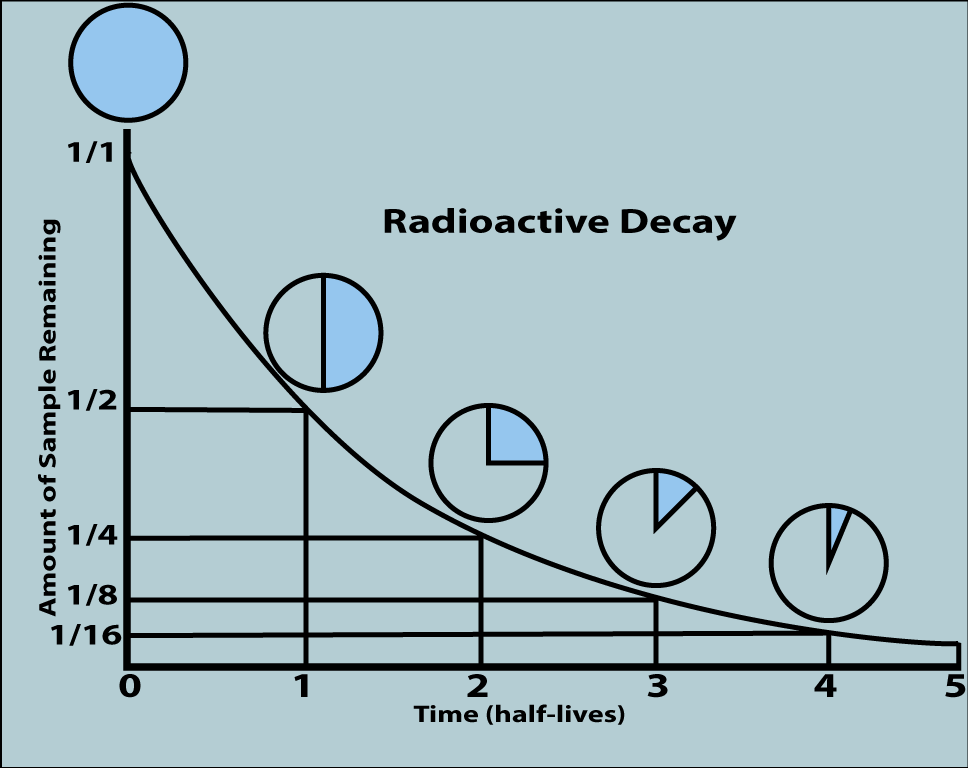
Once you know the half-life of a radioactive element, you can use a graph like the one at left to figure out the age of a sample of igneous rock. Here’s an example.
Potassium is a solid metal. Argon is a gas. As Potassium 40 (40K) decays into Argon 40 (40Ar), the argon gas gets trapped as tiny bubbles inside a rock sample, and the amount of Argon can be measured.
It takes Potassium 40 (40K) 1.3 million years to decay into Argon 40 (40Ar). A scientist is examining a rock sample where the ratio of 40K to 40Ar is 1:1. The scientist uses the graph to find 1/2 on the Y-axis (amount of sample remaining). Looking down at the X-axis, they see that one half-life has passed. That means that the sample is 1 * 1.3 million = 1.3 million years old. If two half-lives had passed it would be 2.6 million years old (2 * 1.3 million).
For more challenging examples, you can use an online half-life calculator, like the one at https://www.calculator.net/half-life-calculator.html (the link opens in a new tab).
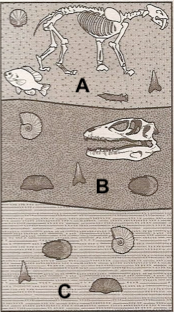 By combining relative dating with radiometric dating, you can hone in on a fossil’s age. Assume that between layer A and B at left, there was a layer of volcanic rock. If that volcanic rock was 10,000,000 years old, then you’d know that the fossils in layer B were more than 10,000,000 years old, and that the fossils in layer A were younger than 10,000,000 years old.
By combining relative dating with radiometric dating, you can hone in on a fossil’s age. Assume that between layer A and B at left, there was a layer of volcanic rock. If that volcanic rock was 10,000,000 years old, then you’d know that the fossils in layer B were more than 10,000,000 years old, and that the fossils in layer A were younger than 10,000,000 years old.
5. Flashcards: Knowing the Age of Fossils
[qdeck qrecord_id=”sciencemusicvideosMeister1961-Knowing the Age of a Fossil (HS)”]
[h]Knowing the Age of a Fossil
[q]Radiometric dating is also known as ______________ dating, and it tells you …
[a]Radiometric dating is also known as absolute dating, and it tells you how long ago a fossil formed.
[q]Relative dating tells you …
[a]Relative dating tells you how old a fossil is compared to other fossils.
[q]Explain what half-life is.
[a]Half-life is the amount of time it takes for half of a sample of a radioactive isotope of an element to change into another element.
[q]Carbon 14 is an isotope of carbon that decays into nitrogen 14. The half-life of carbon 14 is about 6,000 years. If a sample has 1/4 of its original amount of Carbon 14, then how old must it be?
[a]If one-quarter of the sample remains, it means that two half-lives have passed. Since the half-life is about 6000 years, then the sample must be 6000 years * 2, or about 12,000 years old.
[q]What’s an index fossil?
[a]An index fossil is an abundant and easily recognized fossil that can be used to define a particular span of time.
[/qdeck]
6. The Fossil Record as Evidence for Evolution
The fossil record provides several pieces of evidence supporting the idea of descent with modification. We can organize this evidence into three categories.
6a. Fossils show that life has changed over time
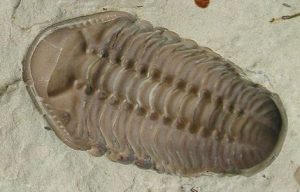
If you examine fossils from a million years ago, you won’t find any modern humans. We didn’t exist (at least not in our modern form). Go back 150 million years, and the only mammals are marsupials (the ones with pouches, like kangaroos. That’s because 150 million years ago, our type of mammal — ones with a placenta, like whales, bears, and bats — didn’t exist. Go back 450 million years ago and there’s no life on land (because life hadn’t yet emerged from the oceans). Go back to 500 million years ago, and the seas would be crawling with trilobites, an arthropod so common (and so well preserved because of its hard exoskeleton) that you can easily buy an actual specimen.
Evolution is about life changing over time. The fossil record shows that this change has occurred.
6b. The type of change found in the fossil record is the kind that evolutionary theory predicts.
The evolutionary biologist J.B.S. Haldane famously joked that one fossil find could disprove the idea of evolution. What would that be? Finding a fossilized rabbit in rocks older than 600 million years old.
Why would a fossilized rabbit in 600 million-year-old strata prove evolution false? Evolution is about descent with modification. Rabbits are mammals, which are the descendants of reptiles, which are the descendants of amphibians (vertebrates born in water, which later develop to live on land, like frogs). Amphibians are the descendants of fish, which emerged 600 million or so years ago.
Evolution, in other words, makes a prediction that sedimentary strata will have fossils in an order that verifies descent with modification. In the case of vertebrates, the prediction is fish before amphibians, amphibians before reptiles, and reptiles before mammals. The fossil record, all over Earth, supports this prediction. It supports a similar prediction for plants. These predictions could be disproved, but hundreds of thousands of fossils have been found and cataloged, and none contradicts this prediction. That’s why evolution is a theory: an organized explanation of some aspect of the natural world that has been thoroughly tested and supported by evidence.
6c. Transitional Fossils show Descent with Modification in a Variety of Lineages
A transition is a period of change from one state or condition to another (Oxford). Teenagers, for example, are in a transition between childhood and adulthood.
Transitional fossils have features that are common both to an ancestral group and its descendants. While it’s usually impossible to know whether a transitional fossil is a direct ancestor of a more modern group, species with transitional features can be seen as models of how the transition occurred. (Wikipedia). Here are a few examples.
6c1. Whales
The images below show a series of fossils in the lineage leading up to modern whales. The lineage shows transitions that include a reduction of hind legs, movement of nostrils to the top of the head, and changes in the shape of the skull that made sonar and echolocation possible.
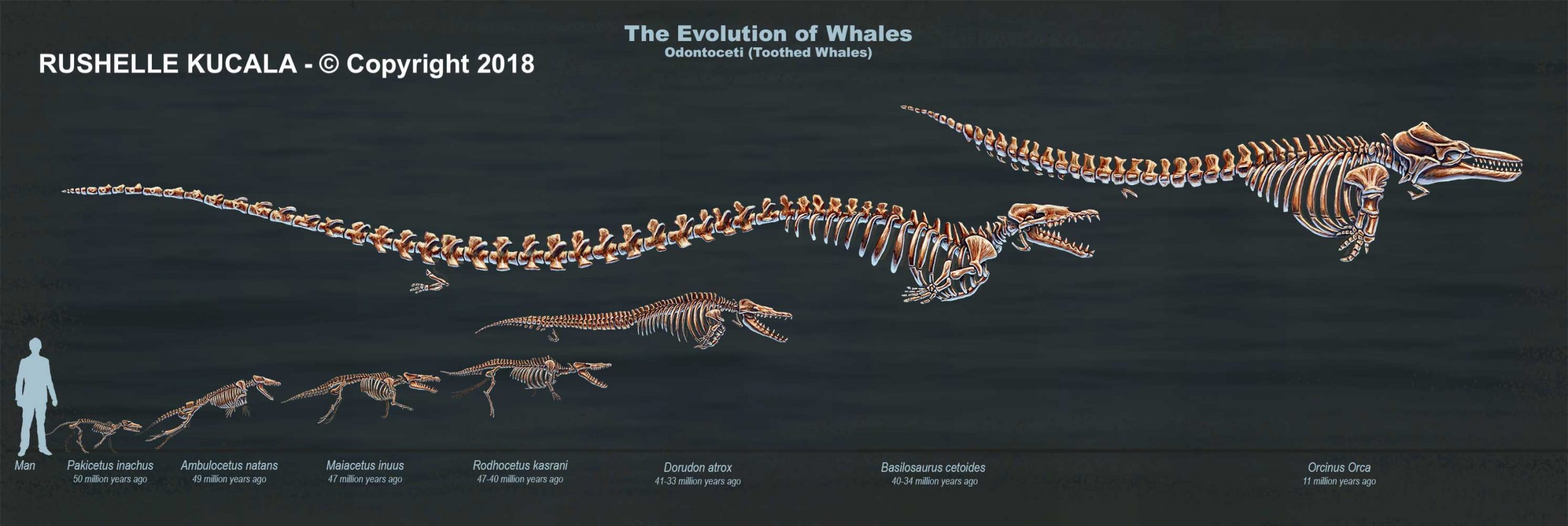
Here are reconstructions of three of these species: The descendants of Pakicetus (an ancient ancestor of whales) transformed from a land-living mammal into an ancient whale like Basilosaurus (which still had external hind limbs. A modern Orca (a killer whale) is shown on the right.
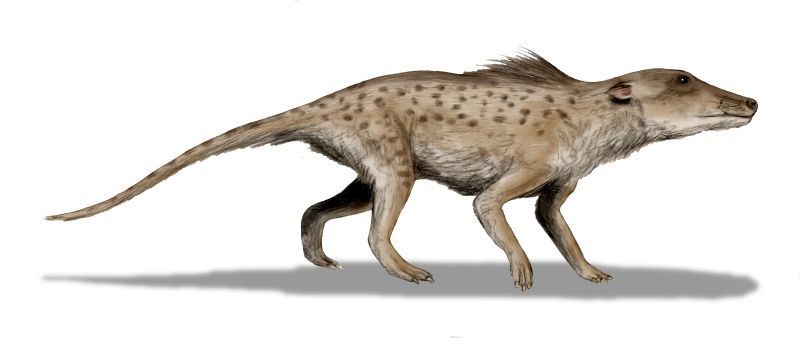 |
 |
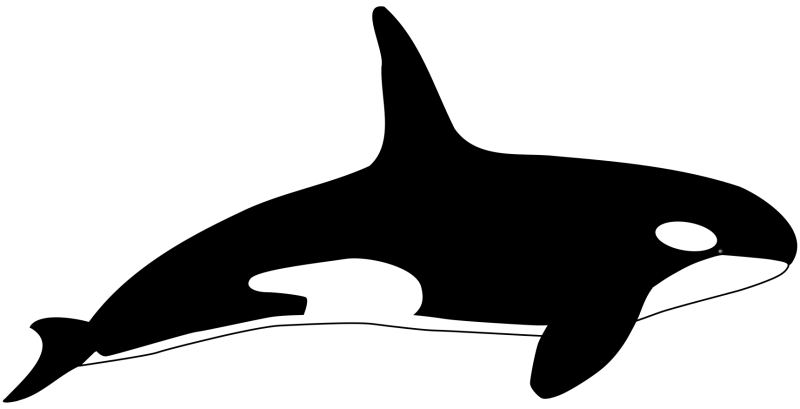 |
| Pakicetus (about 50 million years ago). 1 – 2 meters long. | Basilosaurus (41 to 34 million years ago). About 16 meters long. | Humpback whale (current). 12 – 16 meters long. |
Much of the unearthing of proto-whale skeletons has been done by Philip D. Gingerich at the University of Michigan. You can read his summary of some of the findings here. To learn more about whale evolution and transitional whale fossils, you can read related articles in Smithsonian Magazine, at Wikipedia, or in the NY Times.
What’s the takeaway? Evolution is about descent with modification. The transitional fossils found in the whale lineage show that whales are the modified descendants of land-living ancestors, with a clear line of descent between land-living and completely aquatic forms.
6c2. Birds

Birds are a branch of the dinosaurs. As difficult as this might be to accept, the robin in your front yard is a dinosaur whose ancestors survived the extinction 60 million years ago that killed off the rest of the dinosaurs. That’s true of that hawk soaring overhead, and the pigeons downtown.
Archaeopteryx is a small dinosaur that lived about 150 million years ago. Its fossil was discovered in Germany in 1861. It has many transitional features: unlike modern birds, it has jaws with sharp teeth (instead of a beak). Its wings end with three clawed fingers. Unlike tail-less modern birds, it had a long bony tail. However, like modern birds, archaeopteryx had wings and feathers.
Here’s the fossilized skeleton.
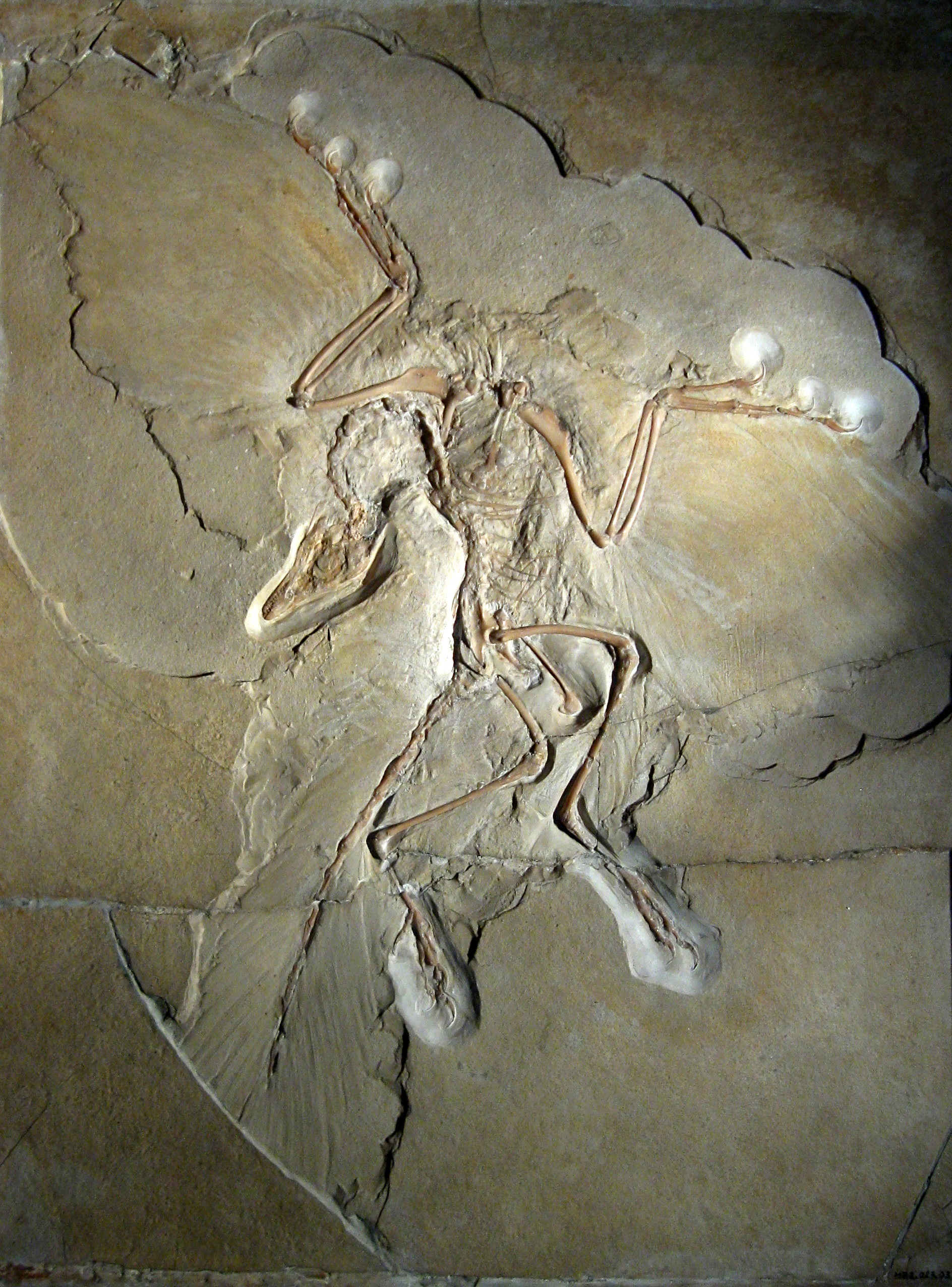
And here’s a reconstruction. Note the claws on the wings.
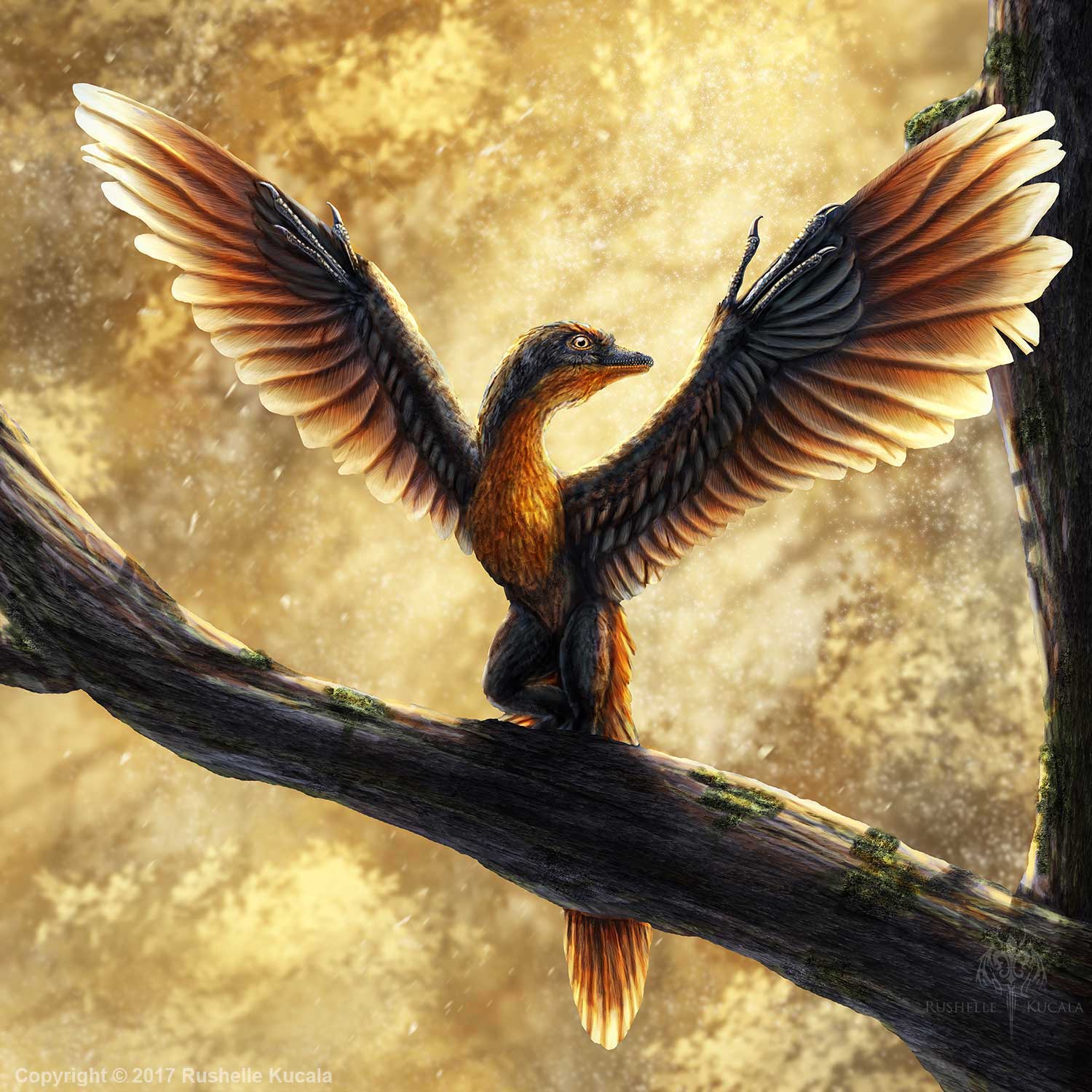
What’s the takeaway? Evolution is about descent with modification. Transitional forms like Archaeopteryx show how modern birds are the modified descendants of earlier forms.
6c3. Tiktaalik and the transition from fish to tetrapods
Tiktaalik is an animal that’s transitional between lobe-finned fish and the first tetrapods (vertebrate animals with four limbs). Lobe-finned fish have fins with stout bones, unlike the more slender rays found in the fins of fish like salmon, tuna, guppies, or goldfish. Tetrapods are the four-limbed vertebrates that walked on land. The group includes amphibians, reptiles, birds, and mammals.
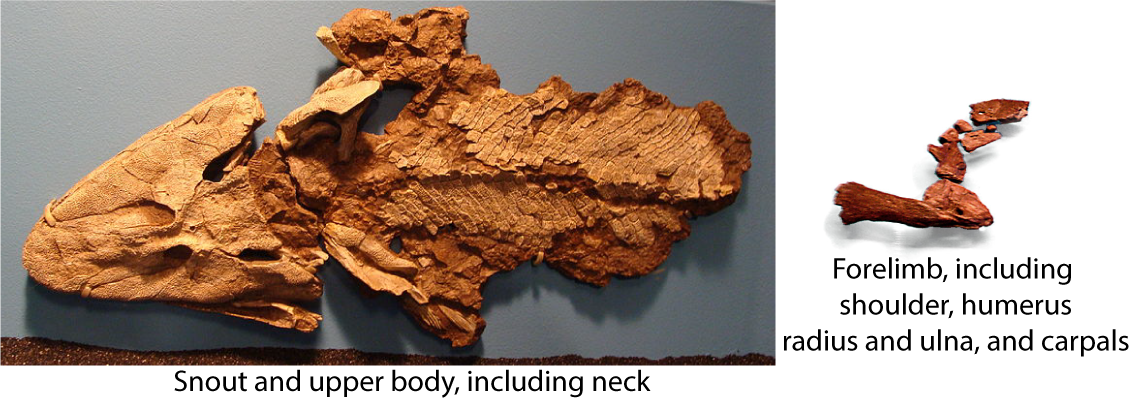
The images above show fossilized remains of Tiktaalik’s snout and upper body (left) and its forelimb. Below is a reconstruction showing what Tiktaalik might have looked like.
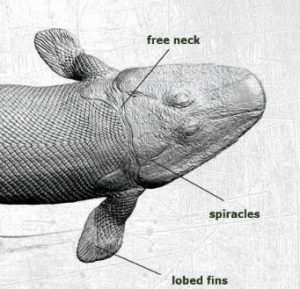
Tiktaalik, whose fossils were unearthed in Northern Canada in 2004, lived about 375 million years ago. Tiktaalik’s features link the lobe-finned fish to their tetrapod descendants. Tiktaalik had the scales and gills that all fish have. But its fin bones, attached by large muscles to well-developed shoulder bones, suggest that this animal could have supported its weight. It also had holes above its eyes (spiracles) that indicate that it had lungs in addition to gills. Its long snout and teeth suggest that it could raise its head just above the water line (like a crocodile) as it scanned for prey in tidal waters.
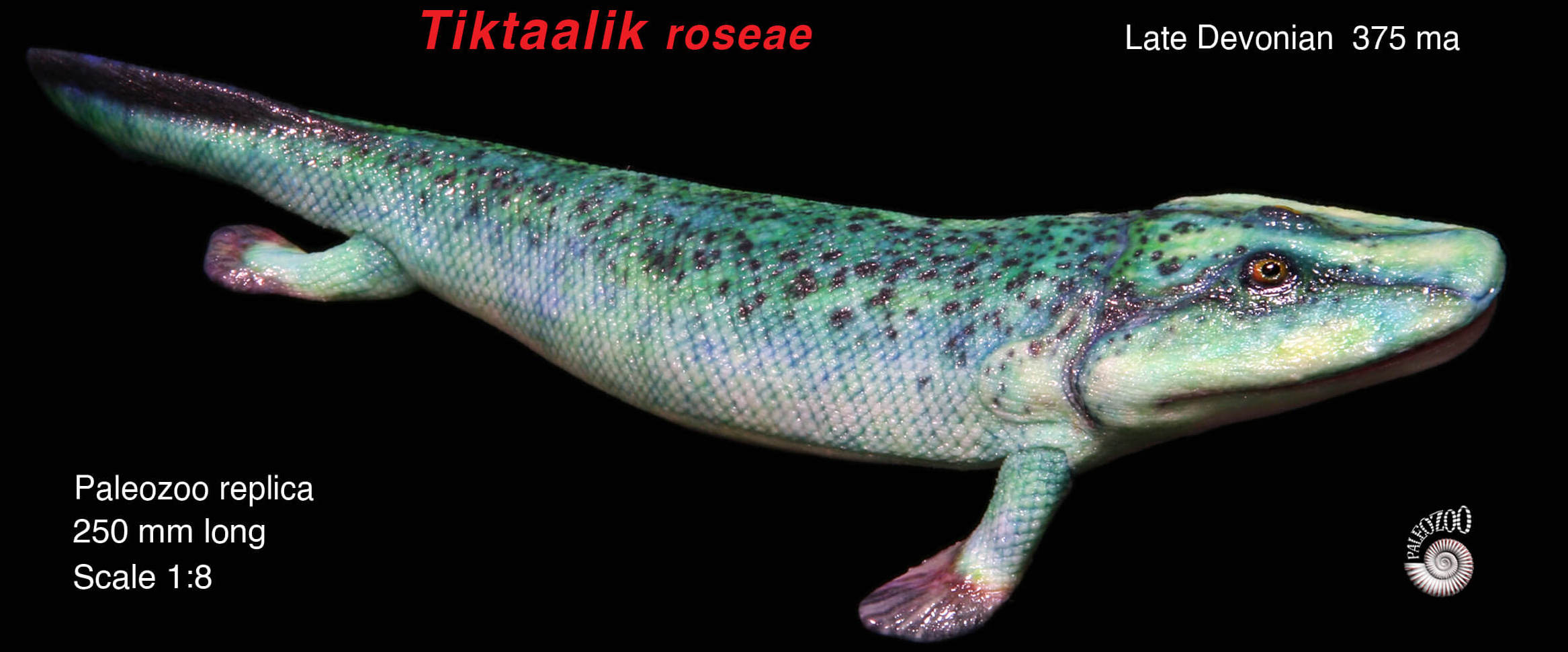
To learn more about Tiktaalik, you can read this brief article in National Geographic, or this much more detailed article in Nature from its three discoverers, Neil Shubin, Ed Daeschler, and Farish Jenkens.
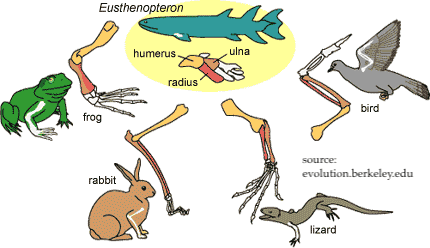 What’s the takeaway? Tiktaalik shows how modern tetrapods (including you and me) are the modified descendants of fish-like forms that adapted to life on land. Tiktaalik might not have been our direct ancestor (it might be on the branch leading to modern amphibians). But it shows how the transition from fish-like forms of vertebrates to modern land-living forms might have occurred.
What’s the takeaway? Tiktaalik shows how modern tetrapods (including you and me) are the modified descendants of fish-like forms that adapted to life on land. Tiktaalik might not have been our direct ancestor (it might be on the branch leading to modern amphibians). But it shows how the transition from fish-like forms of vertebrates to modern land-living forms might have occurred.
7. Fossils as Evidence for Evolution: Flashcards
[qdeck qrecord_id=”sciencemusicvideosMeister1961-Fossils as Evidence for Evolution (HS)”]
[h]The fossil record as evidence for evolution
[q]The fossil record shows that life has ___________ over time.
[a]The fossil record shows that life has changed over time.
[q]The ____________ of changes shown in the fossil record are the kind of changes that evolutionary theory ______________.
[a]The types of changes shown in the fossil record are the kind of changes that evolutionary theory predicts.
[q]In the vertebrate lineage leading to mammals, evolution predicts that the fossil record will show __________ in the oldest strata, then amphibians, then reptiles, then ______________. Everywhere on Earth, this sequence has been confirmed.
[a]In the vertebrate lineage leading to mammals, evolution predicts that the fossil record will show fish in the oldest strata, then amphibians, then reptiles, then mammals. Everywhere on Earth, this sequence has been confirmed.
[q]Why is evolution a theory, and not a hypothesis?
[a]Evolution is a theory because it’s an organized explanation that has been thoroughly tested and is well-supported by evidence.
[q]What is a transitional fossil?
[a]Transitional fossils are fossils that have features that are common both to an ancestral group and its descendants.
[q]Some of the transitional features of Archaeopteryx include …
[a]Transitional features of Archaeopteryx include a boney tail, teeth, and claws.
[q]Transitional fossils are evidence for evolution because…
[a]Transitional fossils are evidence for evolution because they show descent with modification.
[/qdeck]
8. Fossils as Evidence for Evolution: Quiz
[qwiz qrecord_id=”sciencemusicvideosMeister1961-Fossils and Evolution: Cumulative Quiz”]
[h] Fossils and Evolution: Cumulative Quiz
[i] Biohaiku
The Fossil Record
Evolution, extinction
Written in rock
[q multiple_choice=”true”] Fossils form in which of the following rock types?
[c]IElnbmVvdXM=[Qq]
[f]IE5vLiBJZ25lb3VzIHJvY2tzIGZvcm0gZnJvbSBsYXZhIG9yIG1hZ21hLiBUaGlzIG1vbHRlbiBtYXRlcmlhbCBpcyBsaWZlbGVzcywgYW5kIGlmIGFueSBsaXZpbmcgbWF0ZXJpYWwgd2VyZSB0cmFwcGVkIHdpdGhpbiBsYXZhIG9yIG1hZ21hLCBpdCB3b3VsZCBiZSBpbmNpbmVyYXRlZC4gRmluZCBzb21lIHJvY2tzIHRoYXQgZm9ybSBpbiBnZW50bGVyIHdheXMu[Qq]
[c]IE1ldGFtb3JwaGlj[Qq]
[f]IE5vLiBNZXRhbW9ycGhpYyByb2NrcyBhcmUgYnJvdWdodCBkZWVwIHdpdGhpbiB0aGUgZWFydGgmIzgyMTc7cyBjcnVzdCwgd2hlcmUgaW50ZW5zZSBwcmVzc3VyZSBhbmQgaGVhdCB0cmFuc2Zvcm0gdGhlIG9yaWdpbmFsIHNlZGltZW50YXJ5IG9yIGlnbmVvdXMgcm9jayBpbnRvIGFub3RoZXIgZm9ybS4gRXZlbiBpZiB0aGUgcGFyZW50IHJvY2sgd2FzIHNlZGltZW50YXJ5LCBhbnkgZm9zc2lscyB3aXRoaW4gaXQgd291bGQgYmUgZGVzdHJveWVkIGJ5IHRoaXMgbWV0YW1vcnBoaWMgcHJvY2Vzcy4=[Qq]
[c]IHNlZGlt ZW50YXJ5[Qq]
[f]IFllcy4gRm9zc2lscyBmb3JtIHdpdGhpbiBzZWRpbWVudGFyeSByb2Nrcy4=[Qq]
[q] The type of rock in which this fossil is found is a [hangman] rock.
[c]IHNlZGltZW50YXJ5[Qq]
[f]IEdyZWF0IQ==[Qq]
[q] A remnant or impression of an organism that has been preserved in the earth’s crust is known as a [hangman] .
[c]IGZvc3NpbA==[Qq]
[f]IENvcnJlY3Qh[Qq]
[q multiple_choice=”true”] Radioactive dating can only be done with which of the following rock types?
[c]IElnbmVvdXMgKH ZvbGNhbmljKQ==[Qq]
[f]IFllcy4gV2hlbiBpZ25lb3VzIHJvY2tzIGFyZSBmb3JtZWQsIHJhZGlvYWN0aXZlIGF0b21zIHdpdGhpbiB0aGUgcm9jayBhcmUgdHJhcHBlZCBpbnNpZGUuIFN1YnNlcXVlbnRseSwgdGhleSYjODIxNztsbCBkZWNheSBhdCBhIHByZWRpY3RhYmxlIHJhdGUsIGFuZCB0aGlzIGRlY2F5IGNhbiBiZSB1c2VkIHRvIGRhdGUgdGhlIGFnZSBvZiB0aGUgcm9jay4=[Qq]
[c]IE1ldGFtb3JwaGlj[Qq]
[f]IE5vLiBNZXRhbW9ycGhpYyByb2NrcyBjYW4mIzgyMTc7dCBiZSB1c2VkIGZvciByYWRpb2FjdGl2ZSBkYXRpbmcuIExvb2sgZm9yIGEgcm9jayB0eXBlIHRoYXQsIHdoZW4gZm9ybWVkLCB0cmFwcyByYWRpb2FjdGl2ZSBhdG9tcyBpbnNpZGUu[Qq]
[c]IHNlZGltZW50YXJ5[Qq]
[f]IE5vLiBSYWRpb2FjdGl2ZSBkYXRpbmcgY2FuJiM4MjE3O3QgYmUgZG9uZSB3aXRoIHNlZGltZW50YXJ5IHJvY2suIExvb2sgZm9yIGEgcm9jayB0eXBlIHRoYXQsIHdoZW4gZm9ybWVkLCB0cmFwcyByYWRpb2FjdGl2ZSBhdG9tcyBpbnNpZGUu[Qq]
[q labels = “top”] Here’s how radioactive dating works: When igneous rocks (the kind from _____________ ) are formed, ____________ atoms within the rock are trapped inside the rock Subsequently, these elements ____________ at a predictable rate, and this decay can be used to date the age of the rock.
[l] decay
[f*] Correct!
[fx] No, that’s not correct. Please try again.
[l] radioactive
[f*] Great!
[fx] No. Please try again.
[l] volcanoes
[f*] Great!
[fx] No, that’s not correct. Please try again.
[q] The type of rock shown in this cartoon is a [hangman] rock, and the layers within are known as [hangman].
[c]IHNlZGltZW50YXJ5[Qq]
[f]IENvcnJlY3Qh[Qq]
[c]IHN0cmF0YQ==[Qq]
[f]IENvcnJlY3Qh[Qq]
[q] In general, the layers on top of sedimentary strata are [hangman], and the deepest layers are [hangman].
[c]IHlvdW5nZXI=[Qq]
[f]IEdvb2Qh[Qq]
[c]IG9sZGVy[Qq]
[f]IENvcnJlY3Qh[Qq]
[q] In radiometric dating, the time it takes for half of a sample of a radioactive isotope to transform itself into some other form is called the [hangman]-[hangman]
[c]IGhhbGY=[Qq]
[f]IEdyZWF0IQ==[Qq]
[c]IGxpZmU=[Qq]
[f]IEdvb2Qh[Qq]
[q] In the following question, both answers begin with “r.” Dating a fossil based on its position within sedimentary strata is known as [hangman] dating. Dating a fossil based on the decay of radioactive isotopes in nearby volcanic rocks is known as [hangman] dating.
[c]IHJlbGF0aXZl[Qq]
[f]IEdvb2Qh[Qq]
[c]IHJhZGlvbWV0cmlj[Qq]
[f]IEV4Y2VsbGVudCE=[Qq]
[q] The fossil record shows that [hangman] has changed over [hangman].
[c]IGxpZmU=[Qq]
[f]IENvcnJlY3Qh[Qq]
[c]IHRpbWU=[Qq]
[f]IENvcnJlY3Qh[Qq]
[q] [hangman] fossils have features that are common to both an ancestral species, and its [hangman].
[c]IHRyYW5zaXRpb25hbA==[Qq]
[f]IEV4Y2VsbGVudCE=[Qq]
[c]IGRlc2NlbmRhbnRz[Qq]
[f]IENvcnJlY3Qh[Qq]
[q] Transitional fossils such as Tiktaalik validate the evolutionary idea of [hangman] with [hangman].
[c]IGRlc2NlbnQ=[Qq]
[f]IEV4Y2VsbGVudCE=[Qq]
[c]IG1vZGlmaWNhdGlvbg==[Qq]
[f]IEdyZWF0IQ==[Qq]
[q] Archaeopteryx shows features found in both dinosaurs and [hangman]. That makes it a [hangman] fossil.
[c]IGJpcmRz[Qq]
[f]IEdyZWF0IQ==[Qq]
[c]IHRyYW5zaXRpb25hbA==[Qq]
[f]IEV4Y2VsbGVudCE=[Qq]
[q multiple_choice=”true”] Isotope M has a half-life of 1000 years, during which it decays into isotope N. You’re studying a sample of material that has a relative proportion of 25% M and 75% N. How old is this material?
[c]IDUwMCB5ZWFycyBvbGQu[Qq]
[f]IE5vLiA1MDAgeWVhcnMgaXMsIGluIHRoaXMgY2FzZSwgaGFsZiBvZiBvbmUgaGFsZi1saWZlLiBJbiB0aGlzIGNhc2UsIHR3byBoYWxmLWxpdmVzIGhhdmUgcGFzc2VkLg==[Qq]
[c]IDEwMDAgeWVhcnMu[Qq]
[f]IE5vLiAxMDAwIHllYXJzIGlzIG9uZSBoYWxmLWxpZmUuIEhlcmUmIzgyMTc7cyBob3cgdG8gdGhpbmsgYWJvdXQgdGhpcy4gSW4gb25lIGhhbGYtbGlmZSBvZiB0aGlzIGVsZW1lbnQsIHlvdSYjODIxNztkIGV4cGVjdCBoYWxmIG9mIE0gdG8gZGVjYXkgaW50byBOLCBmb3IgYSA1MC81MCByYXRpby4gVGhhdCYjODIxNztzIG5vdCB0aGUgcmF0aW8gaGVyZS4gQmFzZWQgb24gdGhlIHF1ZXN0aW9uLCBmaW5kIHRoZSBudW1iZXIgb2YgaGFsZi1saXZlcywgYW5kIG11bHRpcGx5IHRoYXQgYnkgdGhlIGR1cmF0aW9uIG9mIGEgaGFsZi1saWZlLg==[Qq]
[c]IDIwMDAgeW VhcnMgb2xk[Qq]
[f]IEV4Y2VsbGVudC4gSWYgb25seSAyNSUgb2YgdGhlIG9yaWdpbmFsIG1hdGVyaWFsIGlzIGxlZnQsIHRoZW4gdHdvIGhhbGYtbGl2ZXMgaGF2ZSBwYXNzZWQsIGZvciBhIHRvdGFsIG9mIDIwMDAgeWVhcnMu[Qq]
[q] Which layer from Montana below has fossils that are the same age as layer 3 in Texas?
[textentry single_char=”true”]
[c]ID I=[Qq]
[f]IEV4Y2VsbGVudC4gWW91JiM4MjE3O3JlIHVzaW5nIHRoZSBza3VsbCBpbiBsYXllciAzIGluIFRleGFzIGFzIGFuIGluZGV4IGZvc3NpbCBpbiBvcmRlciB0byB0ZWxsIHlvdSB0aGUgYWdlIG9mIGxheWVyIDIgaW4gTW9udGFuYS4=[Qq]
[c]IEVudGVyIHdvcmQ=[Qq]
[c]ICo=[Qq]
[f]IE5vLiBVc2UgdGhlIHNrdWxsIGluIGxheWVyIDMgYXMgYW4gaW5kZXggZm9zc2lsLiBXaGljaCBsYXRlciBpbiBNb250YW5hIGhhcyBhIHNpbWlsYXIgZm9zc2lsPyBJZiBpdCBkb2VzLCBpdCYjODIxNztzIHByb2JhYmx5IGZyb20gdGhlIHNhbWUgdGltZSBwZXJpb2Qu[Qq]
[q] In the diagram below, the oldest fossils are in layer
[textentry single_char=”true”]
[c]IE M=[Qq]
[f]IEV4Y2VsbGVudC4gSW4gc2VkaW1lbnRhcnkgc3RyYXRhLCB0aGUgZGVlcGVzdCBsYXllcnMgYXJlIHRoZSBvbGRlc3QgKHVubGVzcyBzb21lIGdlb2xvZ2ljYWwgZXZlbnQgaGFzIGZsaXBwZWQgdGhlc2UgbGF5ZXJzIG92ZXIpLg==[Qq]
[c]IEVudGVyIHdvcmQ=[Qq]
[c]ICo=[Qq]
[f]IE5vLiBIZXJlJiM4MjE3O3MgYSBoaW50LiBUaGUgZ2VuZXJhbCBwcmluY2lwbGUgaXMgdGhhdMKgSW4gc2VkaW1lbnRhcnkgc3RyYXRhLCB0aGUgZGVlcGVzdCBsYXllcnMgYXJlIHRoZSBvbGRlc3Qu[Qq]
[x]
[restart]
[/qwiz]
Links
- Biogeography, Analogous features, and Convergent Evolution (the next tutorial in this series)
- Evidence for Evolution Main Menu (High School Level)
